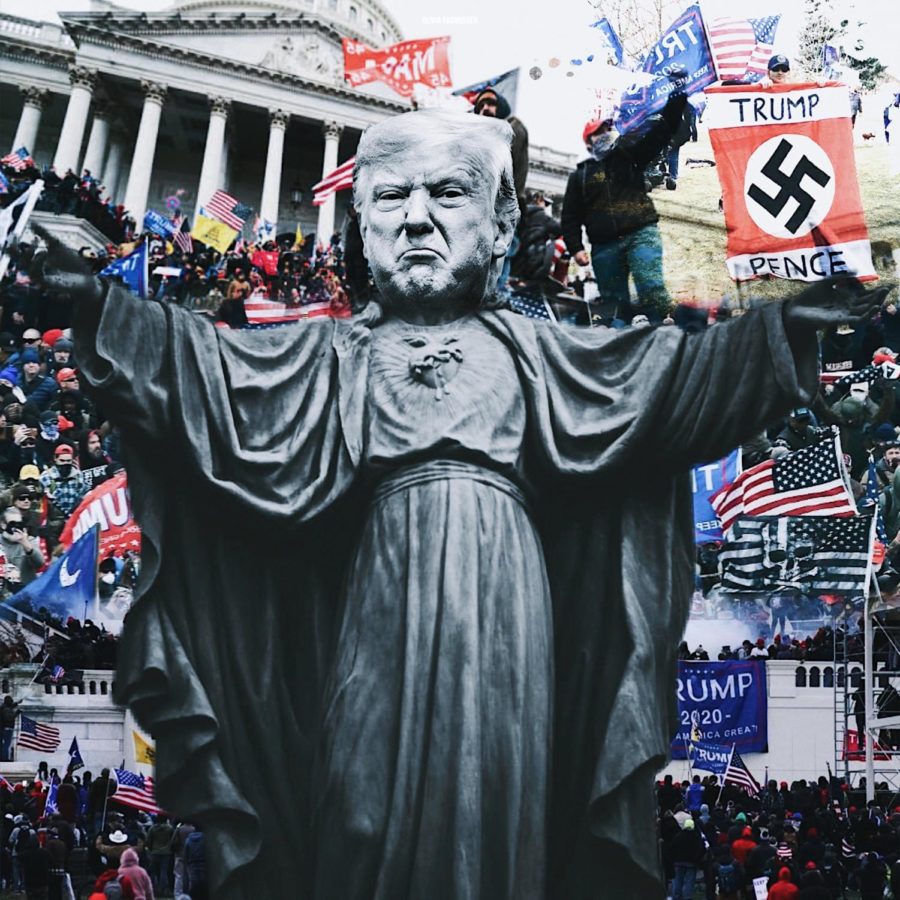Rasmussen: America’s biggest cult
February 5, 2021
It’s been roughly one month since the Capitol insurrection, which was planned and executed by some of Donald Trump’s crazed following, but society is quickly moving past the barbaric rampage without looking at the warning signs of how average Americans can be radicalized on a cult-like level.
The Capitol attack came as a shocker to some people, even complicit Republicans who previously knew what kinds of crowds their ideologies attracted. The reckless attempt to overthrow democracy poses the question — how do average people fall into the patterns of extreme cult-like behavior for a treacherous politician?
First, let’s review the people and groups that were spotted during the Capitol siege: neo-Nazis, white nationalists/supremacists, militias, conspiracy theorists and religious groups. The failed coup is being portrayed as a “one-off situation” caused only by extremists, but was it really? Let’s continue the list: current and former military personnel, police officers, the Blue Lives Matter crowd that ironically murdered a Capitol officer and everyday people who look like our neighbors and family members.
Vox says, “It’s tempting to dismiss the insurrectionists as uneducated or representative of the ultra-fringe parts of society. But reports have surfaced of typical middle-class or sometimes elite Americans at the riots — police officers, elected officials, real estate agents and CEOS. … This sobering realization only reiterates that the insurrection was the doing of everyday Americans.”
Cult expert Steven Hassan tells Vanity Fair that Trump “has all the characteristics of a cult leader, and his followers the qualities of a cult, from the all-consuming devotion to a single malignant narcissist to the daily consumption of ‘alternative facts’ to immunize them against cognitive dissonance (aka reality).”
It’s assumed that most of Trump’s obsessed base probably does not believe that they’re part of a cult. I’d like to list out a few suggested warning signs from the Cult Education Institute and reflect on Trump and a portion of his followers’ behaviors:
“Absolute authoritarianism without meaningful accountability, the group/leader is the exclusive means of knowing ‘truth’ or receiving validation,” “no other process of discovery is really acceptable or credible” and “anything the group/leader does can be justified no matter how harsh or harmful.” These three cult warning signs are consistent with Trump. Even if there are literal facts stacked up against him, including video evidence at that, he and some of his base do not believe it unless it’s tailored to their agenda. The Washington Post reports that Trump made “30,573 false or misleading claims” during his presidency. Lastly, Trump said it himself that he could “shoot somebody” and he wouldn’t lose any of his supporters. His dangerous rhetoric fits the rhetoric of his base, which explains the blundering justifications for any and all of his actions.
“Unreasonable fear about the outside world, such as impending catastrophe, evil conspiracies and persecutions.” This portion is crystal clear with the gleaming support Trump has among conspiracy theorists. According to research done by USA Today, conspiracy group QAnon “baselessly claims that there is a ‘deep state’ apparatus run by political elites, business leaders and Hollywood celebrities who are also pedophiles and actively working against Trump.” This group has been credited for helping with organizing the Capitol coup and radicalizing Trump supporters.
“Extreme obsessiveness regarding the group/leader resulting in the exclusion of almost every practical consideration,” “a seeming inability to think independently or analyze situations without group/leader involvement” and “hyperactivity centered on the group/leader agenda, which seems to supersede any personal goals or individual interests.”
The obsessiveness with Trump from his supporters is reiterated in the ways that they’re fanatically repping various forms of merchandise with his name, face and his “Make America Great Again” slogan on it. There’s even merchandise that equates Trump to Jesus. This full-fledged allegiance and utter codependency from his base has been compared to Islamic extremists. This image shows a side-by-side of a parade of trucks flying Trump flags and a parade of trucks flying ISIS flags to seemingly point out the ways in which groups fueled by guns, hate, violence and religion could be comparable.
Lastly, and most shockingly, is the obedience to a crooked politician like Trump who quite obviously does not have the backs of his supporters. After the Capitol attack, some supporters reported feeling “duped” because Trump did not come to the rescue like they assumed he would.
These comparisons are unsettling. Hassan suggests that out of the 74 million people who voted for Trump, “the real hard-core mind-control cultist” population is “10 to 30 million” and that “if we do a massive effort to educate folks, we can get the majority of people out of this, and hopefully inoculated from any other authoritarian cults that may come along.”

















